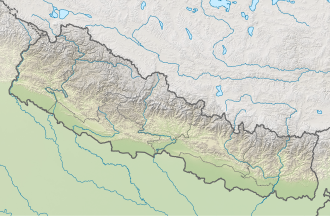| Kirat Chuli | |
|---|---|
| Tent Peak | |
 Kirat Chuli (left) and Nepal Peak (right) | |
| Highest point | |
| Elevation | 7,365 m (24,163 ft) [1] [2] Ranked 76th |
| Prominence | 1,168 m (3,832 ft) [2] |
| Listing | |
| Coordinates | 27°47′29″N88°11′50″E / 27.79139°N 88.19722°E |
| Geography | |
| Location | Nepal / Sikkim, India |
| Parent range | Himalayas |
| Climbing | |
| First ascent | 1939 |
| Easiest route | rock/snow/ice climb |
Kirat Chuli or Tent Peak is a mountain in the Himalayas. It lies on the border between Nepal and India.


